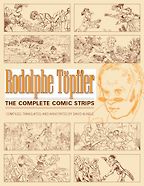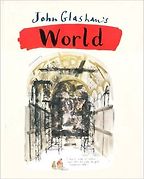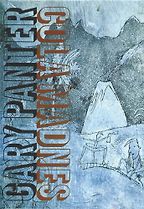Comics, cartoons, sequential art, graphic storytelling, serial drawings, visual narrative. These are some of the many labels given to the work that you do.
Many of these labels are connected to particular traditions but don’t fit the whole field. The problem with “comics” is that they’re not all funny. The problem with “cartoons” is that they’re not all sequential. It’s a very wide and varied field of work that can’t be easily subsumed under one title. Picture stories are an antique medium. Every country has its own name for them. In France it’s a strip drawing. In America many call it comics, because they associate the medium with humour. All these names show the limitations of language in describing something complex.
The minute you see it you know what it is. There’s a million ways to make picture stories. There are short ones and long ones. Some are documentary and some are fiction. Many are funny and many are quite serious. Picture stories have a long and varied history, but because it was never taught in the academy it doesn’t have fixed terminology.
You prefer “picture stories”.
Picture stories is the most neutral and descriptive term. It comes from the German word Bildergeschichten, combining pictures and stories. You could say that the label applies equally well to film and theatre, but those media have their own names. I also call the work I do “autographic writing”. I use that term because it makes clear that the work is part of a literary tradition as well as a visual tradition. Autographic writing gets to the core of it, and shows how important the handwriting of the author is to the form.
How does graphic narrative expand the boundaries of storytelling beyond what can be done with a standard font?
A typographic font is a mechanically reproduced character symbol. Autographic writing is like a seismograph. It goes beyond the use of symbols. It records the psychomotor connection between your brain and your hand. Everybody makes pictures differently; everybody’s handwriting is different.
Theatre is the first place where an image and words were put together. Words were joined with a stage picture or physical acting. Picture stories were an antique technology used to record theatrical events, but then the development of theatre and picture stories diverged. When cinema was invented, there was a way to record theatrical events with photography, so live theatre took another direction. But picture stories go back to the early techniques of recording.
Does the schism between words and pictures go back to the invention of the printing press?
Early books using movable type were not illustrated, because there was a technological problem with putting images into the same matrix as text. Movable type didn’t lend itself to being combined with block-printed pictures. It wasn’t easy to make reproducible images until the invention of lithography, which enabled the illustrated press to take off.
Then there was a division in the academy – the 18th century German institution of specialised education spread across the West – and these two activities became specialised and purified disciplines. There were people who wrote and people who made pictures. That’s why art and literature are entirely separate disciplines to this day. People who made picture stories, like Edward Lear, Rodolphe Töpffer and William Blake, didn’t fit neatly into either discipline. They wanted to cross the boundaries and mix the two. These men were exceptions to the rule that illustrator and writer are two different people.
As we approached 1900, the rivalry between pictures and text turned into antagonism. Serious authors said, “Paying people to illustrate our stories is like paying people to compete with our words.” I think it was Henry James who finally said he didn’t want scenes from his book to have spatial and visual form, because he couldn’t control that. And so we have a hundred years of prose novels without pictures. That’s sort of how it happened.
Let’s begin with the work of the 19th century Swiss artist Rodolphe Töpffer. You named his Complete Comic Strips. Please tell us about the man and his work.
All the people whose books I’m choosing didn’t use pictures as a crutch. They weren’t failed or unformed writers who needed pictures. They excelled in the prose tradition and in the picture-making tradition. They used each as a corrective for the other. Things you can’t communicate with words you can show, and things you can’t show you can convey with words. That’s how movies work, that’s how theatre works, and the paper form of all that is the picture story.
Töpffer’s work consists of highly sophisticated stories, 100 pages or longer. His stories are told through drawings and handwritten text combined on a page. In Western culture, there’s a great taboo against placing text within a picture, so he put the text below each picture, but they worked together. The stories are very entertaining and interesting, very dense and imbued with his handwriting.
Töpffer is credited with inventing the comic strip, isn’t he?
It wasn’t until the 1860s that you could make a reproducible drawing as effortlessly in print as you could on paper. Previously, another technician would take your drawing and translate it into either a wood etching or a steel engraving. With lithographic printing that step was obviated. That’s when Töpffer’s career took off. He was there at the right moment to combine pictures with text.
He was the first person in Western culture to make a large body of literary picture stories. Töpffer was trained to be a writer and his father was painter, so he grew up in a picture-making culture. That’s why he was able to do both. He was a Genevan, from the French-speaking part of what became Switzerland. Because he wrote in French, the tradition he started first developed there, but was pirated all over Europe. By 1842 his work was bootlegged in America.
Next is John Glashan’s World. Tell us about this Scottish artist and his work.
He spans the worlds of words and pictures. He has a very sophisticated literary style and a breathtaking range – from a child’s scrawl to sophisticated topographical drawings. He did a strip, but I don’t think he published much in America. He had much more of a reputation in England.
He’s been called the “Michelangelo of the modern cartoon”. Please explain the comparison.
His strips centre on grandiose architectural scenes in lush watercolours. I would call him more the Turner of picture stories than the Michelangelo.
Glashan once wrote, “A picture, with the addition of writing as part of the design, could form a condensed short story.” Do you agree with the old cliché that a picture says a thousand words?
That equation makes no sense, because pictures and words operate in different spheres of description. Pictures in space, words in time. Pictures can convey things that can only be hinted at with words. Computer code can, but not conventional language.
Let’s talk about the work of an American, Jerry Moriarty. First established as a painter, his picture stories are collected in The Complete Jack Survives.
He trained to be a painter, then at some point in his career he felt the fine art world was too limited. Painting of the 1950s and 60s was too limited to contain his intentions. Jerry wanted to tell stories in a way that transcended the academic disciplines. He has a highly sophisticated approach to picture-making, but he’s also interested in using compositional ideas to tell stories. Many are veiled autobiographical stories about growing up in upstate New York. That’s the theme of Jack Survives. Jack is based upon his father.
Some autographic writing is driven more by text, some is driven more by pictures. Jerry Moriarty is picture-driven. His text is terse, stripped-down language, like dialogue in a play. Imagine if Beckett made a comic strip, and you’ve got the concision and humour of Jerry Moriarty.
His work first appeared in RAW, a magazine edited by Art Spiegelman and published by Françoise Mouly, from 1980 to 1991. How did RAW influence the trajectory of picture stories?
In America, the tradition of newspaper comics aimed at a general audience started around 1895. In 1939 the comic book began, aimed at adolescents and kids. Comic books gave the form a bad name. Much of what was done was simplistic hackwork with a strong violent streak. People trying to use the form for serious literary and visual stories had a hard time finding an adult audience. In the 1970s a lot of oversized visual magazines, like Interview and Wet, were published in America. Art Spiegelman had the idea of packaging picture stories in a format that had connotations of visual and literary sophistication. RAW didn’t look like a 10-cent comic book. It attracted people who read Interview magazine – graphic designers, artists. When the package changed, people looked at what we did differently.
Next up is Gary Panter’s Cola Madnes.
It’s about an imaginary urban wasteland filled with strange creatures. It’s less like a naturalistic novel or a linear narrative than a strange chain reaction, like watching a circus act or scientific demonstration with text. He invents a kind of colloquial American speech that’s very condensed and turns the syntax of normal speech on its head.
Like Jerry Moriarty, Gary Panter is a trained painter. But everybody grows up immersed in popular culture. Some people leave the fine arts completely, like me. I said I never want to show in a gallery, it’s not my world, I want to be in reproduction and mass media. But some people, like Gary, kept his painting activity going. He still does cover design for albums and theatrical stuff, like the sets for [the US children’s TV programme] Pee-wee’s Playhouse. People who work in picture stories tend to be multi-media.
According to a manifesto he published in 1980, Panter sees his art as a means to infiltrate mainstream culture with underground ideas. Are comics particularly well suited to that purpose?
Every mainstream publisher publishes comics now, so either comics have been co-opted or mainstream publishing has been subverted. We were once considered subversive. Mainstream publishing thought comics were junk. It used to be that the worst thing you could say about figures in a novel is that they were like comic strip characters. That was the ultimate dismissal of the author. Now we’ve come to a point where a review in The New York Times said “this novel could probably be done better as a comic strip”. It’s all been turned around.
Finally, Peter Blegvad’s Book of Leviathan. You describe his work as “proof that literature, art and poetry can exist in comic form”. Please explain.
He’s an American who’s lived in England most of his life. His weekly strips in The Independent [newspaper] gave a view of the world through the eyes of a newborn, an absolutely unacculturated creature. Every page is a great revelation.
One of the things the baby grapples with is Hegel. This brings up an issue I have with picture stories. I used to think that cartoons were simple and lighthearted, but the titles you cite and the ones that I see in bookstores seem complex and serious. What do you say to people like me who are scared by your medium?
The world is full of terrible prejudices. There are racial prejudices and there are media prejudices, and they should both be overcome. You have to see the broader picture. The medium of autographic writing is a neutral thing. You can do something really boring with it, or something really interesting. The potential is there in any medium. There are forms in popular culture that were made just to make money. Most novels are terrible – the bulk of books are commercial, Harlequin Romance-quality. But that doesn’t mean you reject literature, does it? A lot of comics are hackwork but I wouldn’t blame the whole media.
On the flip side, before discovering your work, after interviewee Fran Lebowitz recommended one of your books as among the five best about New York, I thought that graphic stories were too challenging to make for relaxing reading.
You have to have both visual literacy and prose literacy. It has to do with education and the way schools are set up. Maybe you weren’t educated to understand pictures. A lot of people have lopsided backgrounds. Editors of magazines specialise in text and hire art directors who are visually literate to oversee the rest. What we need are schools that bridge these academic divides.
Panter designed sets, and Blegvad is a singer-songwriter. You have just finished staging your latest musical, Up From the Stacks. Why are so many picture story artists so polymorphous?
In popular culture there aren’t divisions between disciplines. In popular arts – theatre, movies, comics – that’s the norm. Academic divisions are based on a misunderstanding of how human beings work. Specialisation says that if you can draw, you don’t have to write. If you’re musical, you’re not expected to be literary. We train people to focus on one thing and not do anything else.
In Asian culture – before the introduction of movable type when they started imitating the West – how you wrote your poem was as important as the words you chose. It’s the tradition of Asian calligraphy. To me that makes perfect sense, but it got fractured in the West. In one of the obituaries of Steve Jobs, the first or second sentence explained that the design revolution he started was inspired by his study of calligraphy. The inventors of the personal computers created single-font software with little bitmap letters – they decided words didn’t need materiality. Jobs thought we shouldn’t throw out the whole expressive tradition of typography, and that’s why we all have our choice today. There was a terrible rupture in Western culture between text and picture. It’s time that we correct it.
Five Books aims to keep its book recommendations and interviews up to date. If you are the interviewee and would like to update your choice of books (or even just what you say about them) please email us at [email protected]
Five Books interviews are expensive to produce. If you've enjoyed this interview, please support us by donating a small amount.












